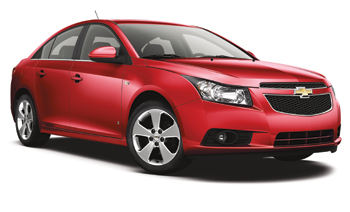
The Chevy Cruze is the replacement for the Cobalt. The Cruze on the outside and under the hood is a big upgrade from the Cobalt, but underneath it is about the same setup as the Cobalt.
Front Suspension
The Cruze uses a strut setup like on the Cobalt. The caster is not adjustable. Camber is adjusted by enlarging the lower bolt hole on the strut-to-knuckle mount. The inner hole should NOT be enlarged beyond that of the outer hole.
Only four out of the 13 fasteners for the front suspension do not have a torque angle specification. It is critical to look up the specifications if you are replacing a control arm, ball joint or tie-rod end.
Steering Angle Sensor Centering
The external column-mounted steering angle sensor does not require centering very often. Centering of the steering angle sensor might be required after certain service procedures are performed. Some of these procedures are as follows:
• Electronic brake control module (EBCM) replacement;
• Steering angle sensor replacement;
• Steering gear replacement;
• Steering column replacement;
• Alignment where the toe was adjusted; and
• Collision or other physical damage.
The external column-mounted steering angle sensor centering procedure can be completed with a scan tool using the following steps:
1. Using the steering wheel, align the front wheels forward;
2. Apply the parking brake, or set the transmission in the P position;
3. Install the scan tool to the data link connector;
4. Ignition ON, engine OFF;
5. Select Steering Wheel Angle Sensor Reset menu for your scan tool;
6. Follow the scan tool directions to complete the learn procedure; and
7. Select Steering Wheel Angle Sensor Learn in the Steering Wheel Angle.
A scan tool can be used or Hunter’s CodeLink tool which is programmed to address re-calibration. Hunter has simplified the process with a seamless transition from the final front toe adjustment to the required reset while on the level surface of an alignment lift.
Rear Suspension
The Cruze uses a semi-independent twist-beam rear suspension axle like on the Cobalt. The axle assembly attaches to the underbody through a rubber bushing and bracket located at the front of each integral trailing arm. The brackets are bolted to the underbody side rails. The axle structure itself maintains the geometrical relationship of the wheels relative to the centerline of the body.
What is new with the Cruz is a Watt’s linkage. The Watt’s linkage is used in the rear axle of the suspension as a performance improvement. This method is intended to prevent relative sideways motion between the axle and body of the vehicle. Watt’s linkage approximates a vertical straight line motion more closely, and does so while locating the center of the axle rather than toward one side of the vehicle, as more commonly used when fitting a long Panhard rod.
It consists of two horizontal equalizer beam links of equal length mounted at each side of the chassis. In between these two links, a short center link is connected. The center of this center link – the point which is constrained in a straight line motion – is mounted to the center of the equalizer beam support. All pivoting points are free to rotate in a vertical plane. Watt’s linkage can also be used to prevent axle movement in the longitudinal direction of the vehicle.
Unlike the Cobalt, the rear suspension on the Cruze is not adjustable with shims. The position of the ABS sensor on the rear hub prevents the use of a shim. Installing a shim would pull the sensor away from the rotating hub ring and cause an ABS fault. If the rear angles are out of tolerances, the rear axle has to be replaced
Recalls and TSBs
The Cruze has been the victim of several high profile recalls. Almost all of the steering column problems have been resolved in the field or on dealer’s lots.
One problem specific to the Cruze has been noise generated by dry contact between the upper strut mount and the spring insulator.
On these vehicles, contact between the strut’s top mount and the splash shield may cause a squeak during normal steering maneuvers at temperatures less than approximately 35°F (2°C).
Raise and support the vehicle until the tires are a few feet off the ground. Rotate the steering wheel to the right until it reaches full lock. When lubricating the strut, try to lubricate as much of the strut circumference as possible. On the left and right front strut, lubricate the rubber washer (1) and top mount (2) using aerosol heavy-duty silicone lubricant. Using the red straw provided, generously spray the lubricant between the top mount and the rubber splash shield.
 The Chevy Cruze is the replacement for the Cobalt. The Cruze on the outside and under the hood is a big upgrade from the Cobalt, but underneath it is about the same setup as the Cobalt.
The Chevy Cruze is the replacement for the Cobalt. The Cruze on the outside and under the hood is a big upgrade from the Cobalt, but underneath it is about the same setup as the Cobalt. 


 The Chevy Cruze is the replacement for the Cobalt. The Cruze on the outside and under the hood is a big upgrade from the Cobalt, but underneath it is about the same setup as the Cobalt.
The Chevy Cruze is the replacement for the Cobalt. The Cruze on the outside and under the hood is a big upgrade from the Cobalt, but underneath it is about the same setup as the Cobalt. 






